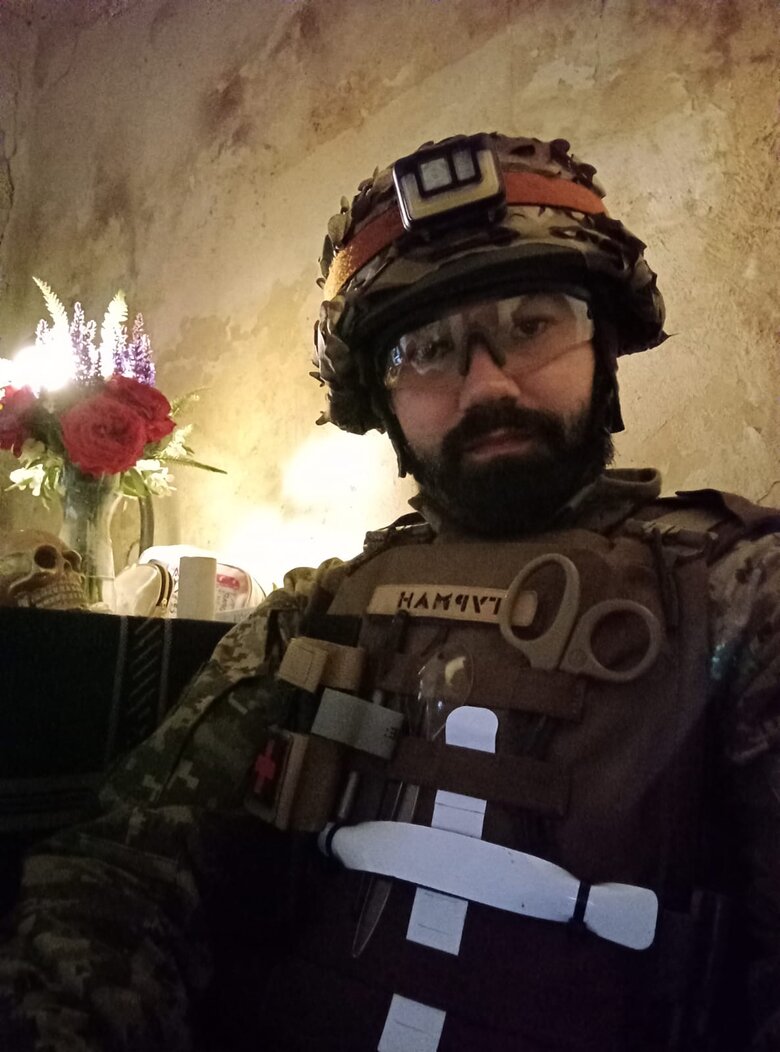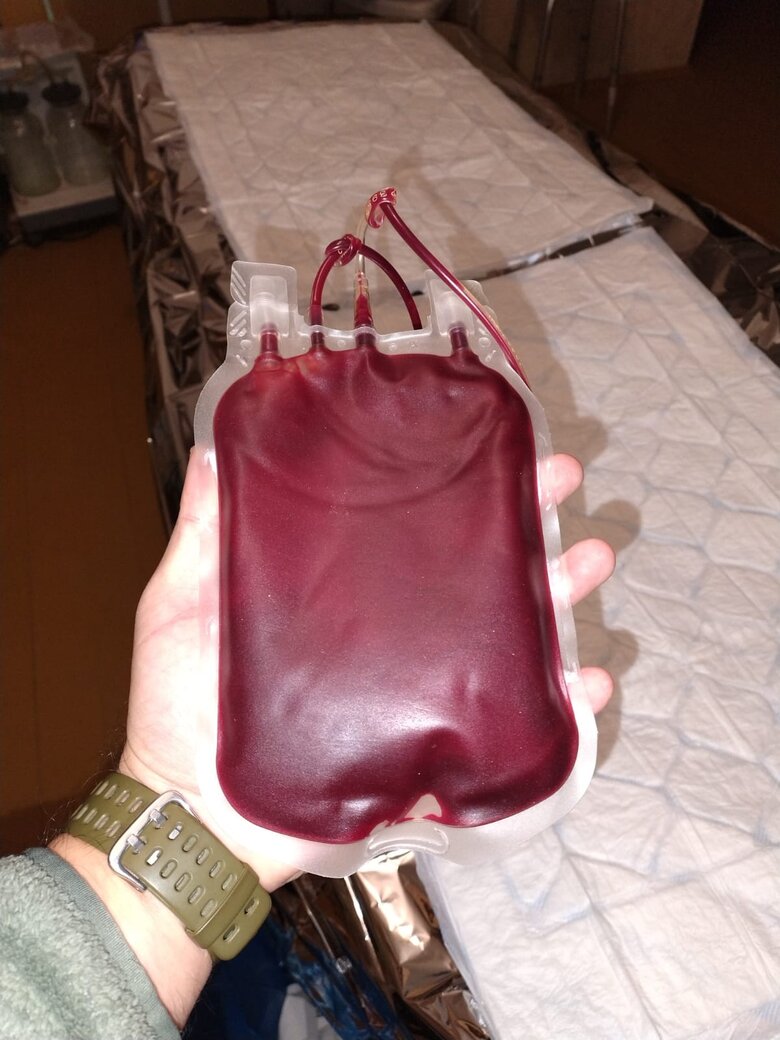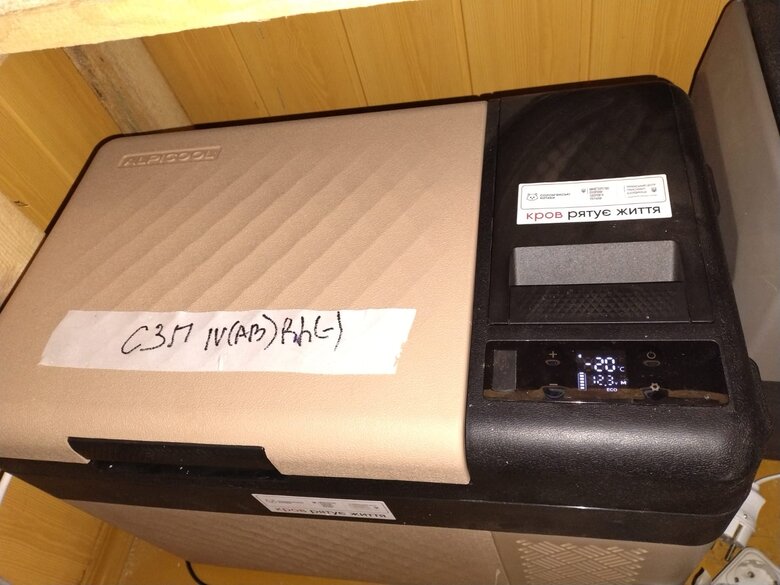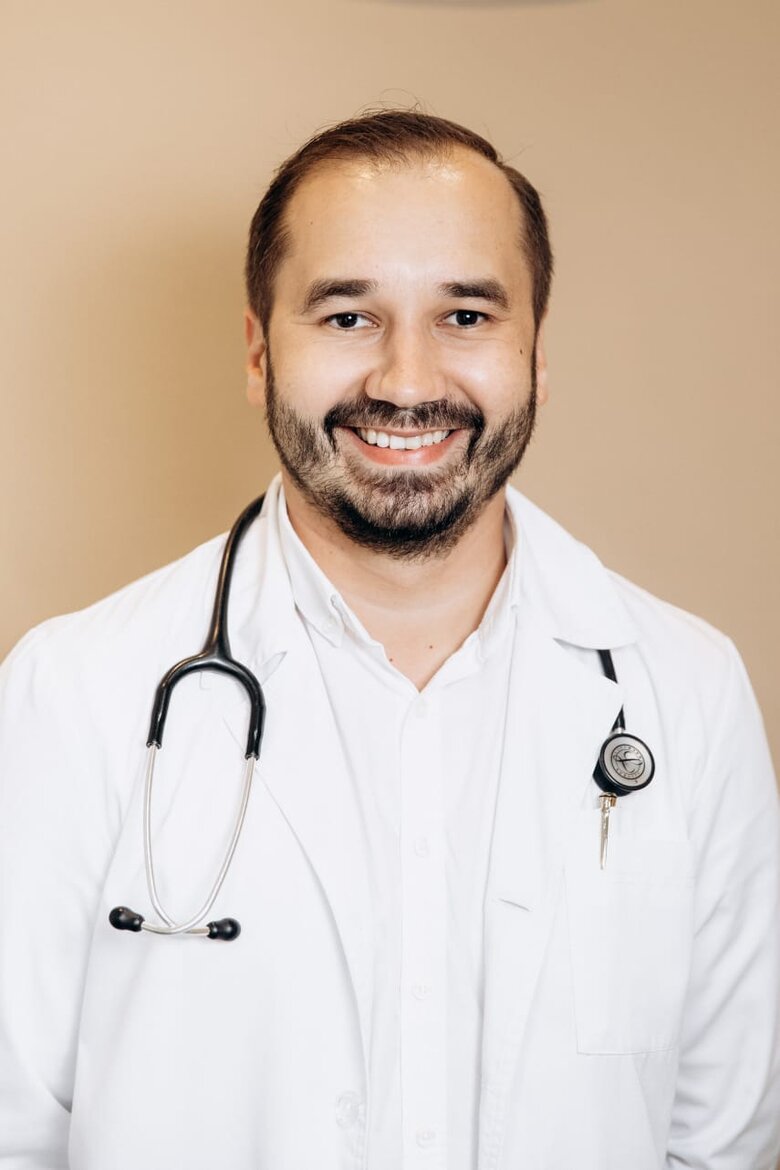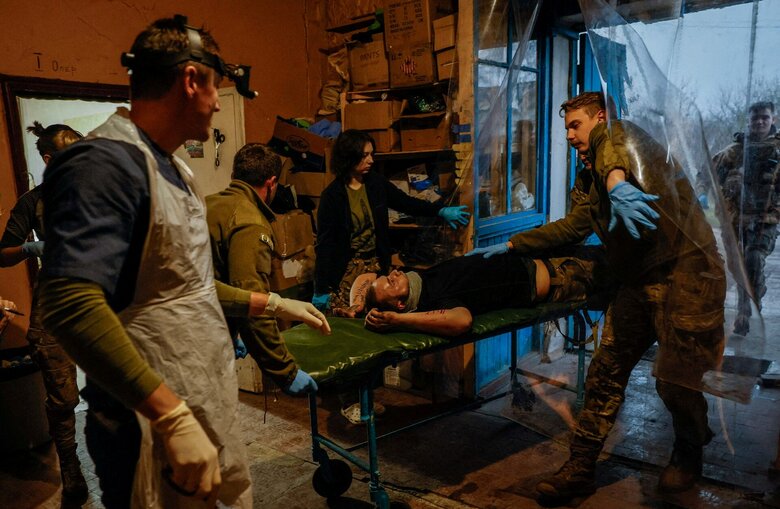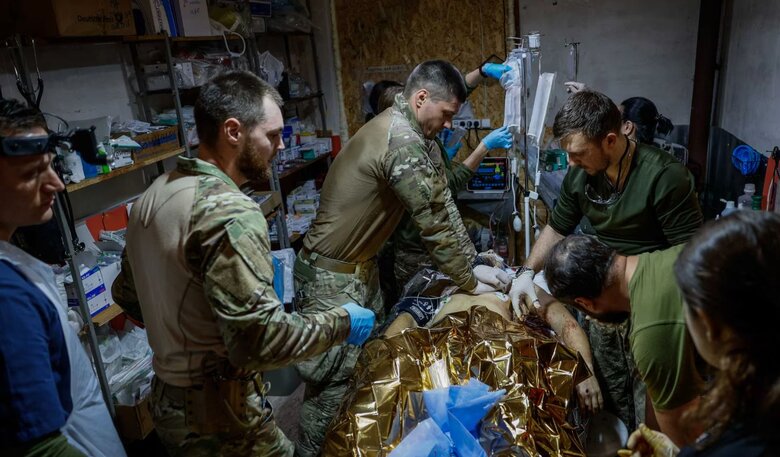Bohdan Panasiuk, doctor at stabilisation point: Wounded were taken from places where it was impossible to evacuate
He is 34, and his wife, son and daughter are worried about him in his native Vinnytsia. Bohdan Panasiuk is part of a medical team that rescues the wounded at the 47th Brigade’s stabilisation point. He has been working in this "hard watch - rest - hard watch again" mode, with a break for occasional vacations, for over 2 years.
What issues does Panasiuk deal with in the stabilisation point? At what temperature are blood products and freshly frozen plasma stored for the wounded? What happens during surgeries? And most importantly, how do Bohdan and his colleagues withstand this enormous physical and moral strain?
Bohdan Panasiuk answered these and other questions in an interview with "Censor.NET".
- Bohdan, your key function at the stabilisation point was described to me as blood coordinator. It sounds powerful - almost like a Master of Life. What does it mean in practice? What should a blood coordinator do during operations and behind the scenes?
- First of all, it is the organisation of all the special equipment that allows us to carry out haemotransfusion at our stabilisation point. We need to have consumables with a strategic reserve. And the second is the organisation of the correct rational ordering of blood products and their sustainable stocks, given that after a certain period of time, blood products expire. It is important that they are available in sufficient quantities, and even if a lot of blood is used quickly, there should be reserve points where we can quickly arrive and pick up the required amount of blood products.
That is, my task is to organise the work itself and order blood products from the so-called blood banks.
- If a wounded person is brought in and his blood type is known, what should you do?
- In most cases, when we already have the blood products at our stabilisation point and the wounded needs them, our anaesthetists are mainly responsible for this. That is, they directly perform the haemotransfusion themselves, observing the process. If they need my help, they call me and I assist them. It is crucial that the blood type and Rh factor of the wounded be determined, and that these data are used to prepare and perform the haemotransfusion itself with the appropriate blood products according to the protocol. The process itself is the prerogative of the anaesthetists themselves.
- What kind of blood volumes and blood storage devices do you have to deal with?
- In each area we visited, the volumes were different. So it's really hard to guide you in this matter. It happened that a few days could exhaust the stock that you had expected for a whole week. And vice versa. On average, it can be up to 10 units per week of relatively low-intensity work.
- Units of what?
- A unit is one haemakon. Of course, they can be of different volumes. Usually it is 450-500 ml of blood.
- Perhaps, the biggest blood consumption at your stabilisation point was in the Avdiivka sector?
- Yes.
- There have been many disputes between activists and supporters of the old line around blood transfusion protocols and all the manipulations involved. As I understand it, your work has increased over the past year and a half, according to the protocols. What about doing this work? Do you have all the facilities to prepare and store this blood? And are you satisfied with the technical arsenal you have?
- In my opinion, I would say that the opposite is true with regard to protocols. The protocols that currently regulate the work directly at our level have even made our work easier. Especially the bureaucratic part. As for the technical part - storage, devices that allow for quick heating - this is mostly our concern. Is it always possible to fully comply with what is written in the protocols? We try our best. For example, we have to store blood products at positive temperatures up to +6 and freshly frozen plasma below -20. So, while we can still more or less store blood products up to +6, even if the power goes out (we have generators and other means of alternative power supply), it is much more difficult with -20, because such devices require a lot of energy. Therefore, it is much harder to keep freshly frozen plasma at the stabilisation points. But we try to have both.
- Really complex nuances.
- Also, perhaps, one of the most important things is the devices that heat the blood. In these devices, the blood flows at high speed and must already be heated to 38 degrees. But there are not many such devices and their consumables are usually very expensive.
- How precious are they?
- The cost of one consumable is around UAH 1000-1500. That is, one patient - one consumable.
These are the main difficulties we face. However, when it comes to ordering blood products and arranging logistics, the regional coordinators almost always meet us halfway. They directly order the blood from the centres and help with its delivery to us. That's why I said that these protocols have made our lives much easier.
- Bohdan, before the outbreak of full-scale war, you worked in civilian medicine. Where exactly?
- At the beginning of my career, I worked at the Vinnytsia Regional State Children's Hospital. After about three years of work, I moved to private medicine and worked as a regular paediatrician on an outpatient basis. In addition, as a family doctor (more like a family paediatrician, although we don't have such a concept), I was engaged in the examination and treatment of children from 0 to 18 years old.
- And how did you end up in the Armed Forces?
- Absolutely standard - mobilisation. I was not a volunteer. I was doing my job, but I knew that if I was called up, I would be ready and go. In September 22, I was mobilised into the Armed Forces of Ukraine.
- How did you get to the 47th Brigade?
- A friend of mine worked in the 47th Brigade, also in the medical field, as an instructor. Having talked to him beforehand, I came to the conclusion that it was a pretty good structure. That's why I actually went straight to the 47th Brigade on the basis of a relation-sheet, which was more or less working at the time.
- Is there a job for a paediatrician of your specialty at the station?
- No, I am not fulfilling my duties as a paediatrician here. Except remotely - to treat the children of my colleagues (smiles - Y.K.). I provide consultations, treat and help. That's what I do. As for the civilian population, I have managed to provide assistance several times over the past 2 years. And those were isolated cases.
- During the fighting for Avdiivka, a Reuters team visited your hospital and made a report Ukrainian medics race against time to save wounded soldiers - November 17, 2023 | Reuters about your work with your colleagues. I'd like to ask you to comment on two photos from this report to give our readers an impression of how the surgery process works.
So, the first photo is of the wounded man being delivered to the stabilisation point. Who is doing what in this photo?
Photo: REUTERS/Alina Smutko
- The room where they brought the wounded man was a so-called triage or sorting room. But there was a clear situation there - if you look closely, the wounded man had a bandage on his lower jaw. I even remember that case: it was an injury, I think, caused by a mine-blast trauma. It was not just the soft tissue in the lower jaw that was damaged, but the bone itself. There were significant defects there, and it was necessary to take care of the airway patency first. That's why the photo shows the wounded man being brought from the street to the triage room, where we examine him for other injuries. We quickly cut off his clothes. At the same time, we ask if he was injected with anything, if he received any assistance, and how old the injury was.
- I see. What's next?
- Then, when our wounded are examined and, if there are other wounded, sorted, we bring him - and in this situation we brought him - directly to the surgical table, to the so-called red zone, where he received the medical care that is provided at our level.
It looks like this. All the medics in this photo are employees of our stabilisation point, together with the crew who were on duty there in case of a pick-up.
- At this first stage, when the wounded is brought in and prepared for surgery, what are the main rules? What must be done and what must not be done in any case?
- Be sure to check for other wounds. They can be subtle, somewhere on the back. Therefore, we must cut off all the clothes (or remove them, if possible) and examine him quickly but thoroughly, according to the algorithm.
Secondly, if we receive people in a state of clinical death (cardiac arrest, respiratory arrest), we immediately begin to carry out resuscitation measures.
What should not be done at all? Hurry up and touch the turnstiles that have been installed. Because we are not sure whether they can be lowered; how long they have been there. If they have been there for a long time, they cannot be lowered.
- Why?
- Because toxins have already accumulated below the turnstile. And if we abruptly remove the turnstile after it has been in place for a long time without first providing appropriate medical care, it can be fatal for the wounded.
- Another photo. We see a surgery - do you remember which one?
PHOTO: REUTERS/Alina Smutko
- This is a wounded man who was brought to us right after the fighting. He was already in a state of clinical death. He had stopped breathing. You can see that one of our employees is performing cardiopulmonary resuscitation. Also on the right, you can see a catheter that takes excess air and blood from the chest cavity. Because it was the chest that was injured. But the blood comes out of the catheter immediately. And since it was in large quantities, we immediately connected empty sterile haemacons (blood collection bags) and then performed a so-called reinfusion. That is, when the hemacone was full, we lifted it, filled it into the heating and filtration system, and then supplied the same blood to the same wounded man. At the same time, intubation and other medications were being injected. And there, I remember, were more injuries. We provided assistance to fully conduct haemostasis and stop the existing bleeding.
This is how these processes went. Usually, 7-8 people work with such wounded at once.
- Do you remember how it all ended for this wounded man?
- It is hard to remember. I can only give you statistics that are almost the same as in civilian life: out of ten wounded who arrive in a state of clinical death, usually one survives, maximum two - when there is successful resuscitation and we start him at the stabilisation point.
- As you said, there are many people involved in the rescue of this wounded man in this photo. Let's go through them in a clockwise direction - what are they doing? Let's start with the person on the left in the blue, white apron.
- This is our surgeon who performs the surgical work.
- Next is a bearded man in blue gloves.
- He usually provided medical care by assisting surgeons.
- The third one seems to be doing CPR, but this is just my amateurish impression...
- This is the so-called cardiopulmonary resuscitation - he puts pressure on the chest. This employee worked on several of our evacuation crews and knew this technique, so he also helped.
- Is the fourth person, a woman who is partially covered in the photo, an anaesthetist?
- Yes, and she injects the wounded man with special fluids, also heated, and other medicines that help to restart his heart. And in the next few minutes, I had to give her a filled blood bag. Then she will fill it up and start infusing the wounded with the blood that was taken from his chest.
- The next photo on the right shows another woman, also half-closed.
- This is our operating nurse. This is me from the back. This is when the blood is flowing through the catheter, and this bag should be much lower than the body level. That's why I'm bent like this. I have to constantly shake this bag so that the preservative in it mixes evenly with the blood and allows it to have normal conditions for storing its properties.
- A man in white gloves stands behind you.
- He is also a surgeon. There are two of them in the photo. He is just placing a catheter to drain air and blood from the chest.
- And finally, a black-haired woman standing with her back to the photographer. Who is she?
- An anaesthetist. She has been a faithful assistant to our anaesthetists for a very long time.
- Of course, days differ. The areas of work and periods of military operations vary. But near Avdiivka, on average, how many such surgeries did your team carry out per day?
- It happened that 2 operations were required if it was a case of clinical death, but this happened 1-2 times a week. But if a person was still conscious or in a clouded state of mind, but with severe injuries, there could be as many as 5 or even more of them per day.
- Bohdan, on those difficult days when you lose a person in surgery, how do you reanimate yourself afterwards? Is it better for you to think about them, to feel sorry for them? Or is it vice versa - it is very important to cut off these impressions, because you need to move on and help those who are still alive?
- Of course, a summary of the work is made - briefly, for each of us. But in no case did we get emotionally involved. Because in reality, what you are talking about triggers you a little bit later, and does not allow you to concentrate properly and provide medical care in the next case. How did we recover from this? Usually, the picture is as follows: when an incident like this happens and we fail to resuscitate the wounded, perhaps the first 5-10 minutes are emotionally difficult. We all leave, and everyone tries to abstract themselves, to immerse themselves in something as much as possible: someone in a book, someone on the phone, someone in a conversation, someone just goes to eat. This goes on for about half an hour or an hour. But this is if you have the opportunity to relax.
- And if not?
- Then there are other wounded. And you just forget yourself, you work automatically. But over time, you somehow learn. I wouldn't say that it's a switching off of emotions. They don't switch off. But it's probably a dulling of emotions.
- Doctors at the station work on a shift basis. How long does one of your shifts last?
- Now it's two after two. But it could be 4 after 4. Or 7 after 2. Depending on whether there is a replacement.
- They can also call because they don't have enough hands.
- Where we are now, it's not very easy to call us out of turn, due to certain circumstances. But there were times when we were called. Even when you are on a rest for a day or two... By the way, in the Avdiivka area, we worked day after day all the time. And for several months, it happened that they simply called you on your rest day, you ran and worked again.
- When you have these two days off, what do you do? First, of course, to sleep. And apart from that? How do you manage to disconnect your head from hard work?
- First of all, sleep, you said it right. And then what? I'm really immersed in books right now. I try to alternate between different genres - fiction and science.
- What are you reading? Name your last three books.
- I will say this. French writer Laurent Gounel's "I Promise You Freedom" - I've just read it. Now I've started reading "How to Talk to Kids About Anything". It's a bestseller by Robyn Silverman, and I'm interested in it because I'm a father of two. And yet I always read the Bible.
- Are you a person of faith?
- Yes.
- For many people, especially non-believers or doubters, the issues of war and faith often conflict. Typical questions arise, such as: if there is a God, why is it possible for so many children and people to die? You see it - this death is happening right in front of your eyes. How do you resolve this dilemma for yourself ?
- I would like to have it resolved. But to be honest, I don't know. Although I have a certain understanding about it. I understand that God is always there. Because apart from this grief, misery, tears, deaths, we see many different things that cannot be explained in a rational way. There are not even dozens, but hundreds of cases when the wounded come and show us their helmets and bulletproof vests that, in all logic, should have led to death or significant injuries and maims, but none of this happened. There were also those who said that we were actually saying goodbye to our lives, we were surrounded, semi-surrounded, but, they say, inexplicably, we are here!
Or in the south, when I was not yet at the stabilisation point. During the counter-offensive, I worked in one of the crews of medical evacuation. We were evacuating the wounded from Mala Tokmachka, and there were cases when people said, we understand clearly that we were just praying, and thus from those places from which it was impossible to evacuate in any way, we actually evacuated them easily wounded.
So this is what I want to say. I see that God is there, He is with us and on our side. It's just that this grief, this misfortune, why it happened to our country and why it has lasted for so long - I cannot give an exact answer. Although there are certain reflections on this.
- Bohdan, where did you get your nickname, Gourmet? Did someone make a joke when they saw you eating something with an aesthetic look?
- Yes. And they immediately gave me this call sign. Not me, but my colleagues, the girls. They observed how delicately I approach eating certain dishes, combining flavours, and generally how I treat food. For me, this is something special. Even some people are in no hurry to have lunch and dinner unless I give my expert opinion (smiles - Y.K.). That's why Gourmet somehow stuck. Although most people address me by my first name.
- Our conversation today coincided with a massive rocket attack in the morning by ruscists in Ukraine. Vinnytsia and the Vinnytsia region were also involved. Did you follow the progress of this attack? After all, it's your hometown, your wife, children, family, friends.
- I follow the Vinnytsia region, no matter where I am. I try never to get too emotional here, because I realise that I can't do much about it. But in the morning, my wife and I - as is probably the tradition of all married people - we are quick to write off and try to always respond.
- Maybe you could send greetings to Vinnytsia with this interview? Not necessarily to your wife, but to your children or family?
- I always tell my children and wife everything in person. These are very close people to me, and I try to keep these relationships private. You must have noticed on my social media - I generally do not like to bring life to the public. And so, who I would like to single out and say good words to is my friends for their support. They mostly live in the Old Town, one of Vinnytsia's neighbourhoods. They always support me, both physically and emotionally.
I would also like to remember with kind words my team, where I worked and hopefully will continue to work. Where I provided and, I hope, will continue to provide assistance to young children.
- Bohdan, at the end of the interview, I usually invite readers to donate to the needs of the unit of the hero or heroine of the conversation. What will we donate to in your case?
- For car repairs. Because the roads here, where we are now, are in extremely poor condition and cars break down almost every week.
- And without cars, the wounded simply cannot be transported to your stabilisation point. Well, strength and good luck to you and your team, Gourmet! May God bless you.
Attention: Those wishing to help Bohdan Panasiuk's medical company with the repair of evacuation vehicles can donate here:
https://send.monobank.ua/jar/2Gx8uQiR7z
Yevhen Kuzmenko, "Censor.NET"
Photo: from the archive of Bohdan Panasiuk

